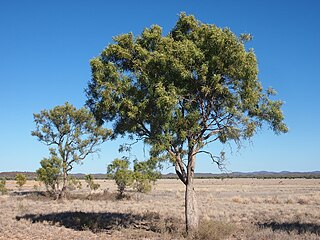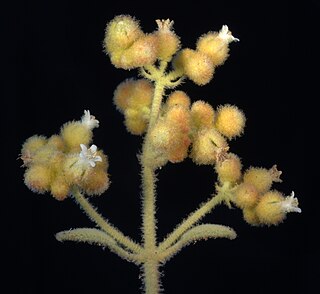
The Great Sandy Desert (GSD) is an interim Australian bioregion, located in the north west of Western Australia straddling the Pilbara and southern Kimberley regions. It is the second largest desert in Australia after the Great Victoria Desert and encompasses an area of 284,993 square kilometres (110,036 sq mi). The Gibson Desert lies to the south and the Tanami Desert lies to the east of the Great Sandy Desert.

Bush tomatoes are the fruit or entire plants of certain nightshade (Solanum) species native to the more arid parts of Australia. While they are quite closely related to tomatoes, they might be even closer relatives of the eggplant, which they resemble in many details. There are 94 natives and 31 introduced species in Australia.

Solanum ellipticum is known as potato bush and under the more ambiguous name of "bush tomato". The Arrernte name of merne awele-awele might refer to this species, and/or to the similar S. quadriloculatum. Native to Australia, the potato bush is a small fruiting shrub in the family Solanaceae.

Solanum quadriloculatum is known under the (ambiguous) common names of "bush tomato" or "wild tomato". It is a small fruiting shrub in the family Solanaceae. It was and occasionally still is included in S. ellipticum by some authors, but generally these two species of "bush tomatoes" are considered distinct nowadays.
George Chippendale was an Australian botanist and a strong proponent of growing Australian Native plants. As well as a career in botany, he also taught his love of botany to all who would listen through talks to children, special interest groups, walks on Canberra'a Black Mountain and more recently through the U3A, both in class and online. He knew the value of planting local native plants in gardens as they would survive local conditions and save water.
Solanum cowiei is a small fruiting subshrub in the family Solanaceae. It is endemic to the Northern Territory in Australia. The fruit is a green berry, up to 15 mm in diameter, that later becomes black-green and detaches from the calyx.
The Eremaean province is a botanical region in Western Australia, characterised by a desert climate. It is sometimes referred to as the dry and arid inland or interior region of Western Australia

Acacia monticola, commonly known as red wattle, gawar, curly-bark wattle, curly-bark tree and hill turpentine, is a species of plant in the legume family that is native to northern Australia.

Atalaya hemiglauca, commonly known as whitewood or cattle bush, is a species of plant in the soapberry (Sapindaceae) family. It is native to northern and inland Australia where it occurs from Western Australia through the Northern Territory and South Australia to Queensland and northern New South Wales.

Acacia sibirica, commonly known as bastard mulga or false witchetty bush, is a tree or shrub belonging to the genus Acacia and the subgenus Juliflorae. It is native to arid areas of Australia.

Acacia chippendalei, commonly known as Chippendale's wattle, is a shrub belonging to the genus Acacia and the subgenus Lycopodiifoliae endemic to northern Australia.
The botanical provinces of Western Australia delineate "natural" phytogeographic regions of WA, based on climate and types of vegetation. John Stanley Beard, in "Plant Life of Western Australia" (p. 29-37) gives a short history of the various mappings.

The Pilbara shrublands is a deserts and xeric shrublands ecoregion in Western Australia. It is coterminous with the Pilbara IBRA region. For other definitions and uses of "Pilbara region" see Pilbara.

Dicrastylis exsuccosa is a species of plant within the genus, Dicrastylis, in the family Lamiaceae. It is endemic to inland Australia and found in Western Australia, the Northern Territory and South Australia.

Maireana pyramidata is a species of plant within the genus, Maireana, in the family Amaranthaceae. It is endemic to Australia, and widespread throughout Australia in the inland, where it is found in Victoria, New South Wales, Queensland, the Northern Territory and Western Australia.

Scaevola basedowii is an erect multi-stemmed shrub in the family Goodeniaceae, endemic to Western Australia, the Northern Territory and South Australia.

Scaevola browniana is a shrub in the family Goodeniaceae, endemic to Western Australia, the Northern Territory and Queensland.

Newcastelia cephalantha is a species of plant belonging to the mint family, Lamiaceae, and native to several Australian states: Queensland, South Australia, Western Australia and the Northern Territory

Sauropus arenosus is a plant in the family Phyllanthaceae, native to Western Australia and the Northern Territory.
Yinarupa Nangala is a Pintupi from Western Australia. just west of the Kiwirrkurra community. Her works are held in major art collections including the Art Gallery of NSW, Museum and Art Gallery of the Northern Territory, and the National Gallery of Victoria.















